Marketing Qualified Lead (MQL): Definition, Examples & Tips
Imagine the following scenario.
You pass by an ice cream place every day on your way to work. Every time you peek through the window just to see which flavors they offer. One day, while you’re contemplating whether to walk in or not, the store manager greets you and hands over a flyer with all the flavors available.
In this situation, the store manager recognized you as a marketing-qualified lead with a high potential of becoming a customer. And such situations happen in every business, no matter what it sells.
But what is a marketing qualified lead exactly? How do you recognize one? And what marketing efforts do you need to take to attract more MQLs?
Keep reading to find out the answers.
What is a Marketing Qualified Lead (MQL)?
A marketing qualified lead (MQL) is a prospect that has passed all the criteria set forth by your marketing department but requires more nurturing to become a buying customer.
Now, what are the criteria that differentiate a marketing qualified lead from all other prospects?
The list of requirements will vary depending on the goal of your lead generation campaign, but here are the most common examples:
- Website/web page visits
- Content downloads
- CTA clicks
- A filled-in online form
- Comments/likes/shares of social media posts
Apart from these criteria, it is also important for the prospect to fit your ideal customer profile (ICP). If a person downloads your ebook but does not fit the target audience demographic/firmographic, the likelihood of them being a potential buyer is very low.
Marketing Qualified Lead (MQL) vs. Sales Qualified Lead (SQL)
As we already mentioned in our lead generation guide, there are two main types of leads – marketing-qualified and sales-qualified. However, the difference between the two is not always easy to spot.
Take a look at this graph that gives a brief overview of both lead types:
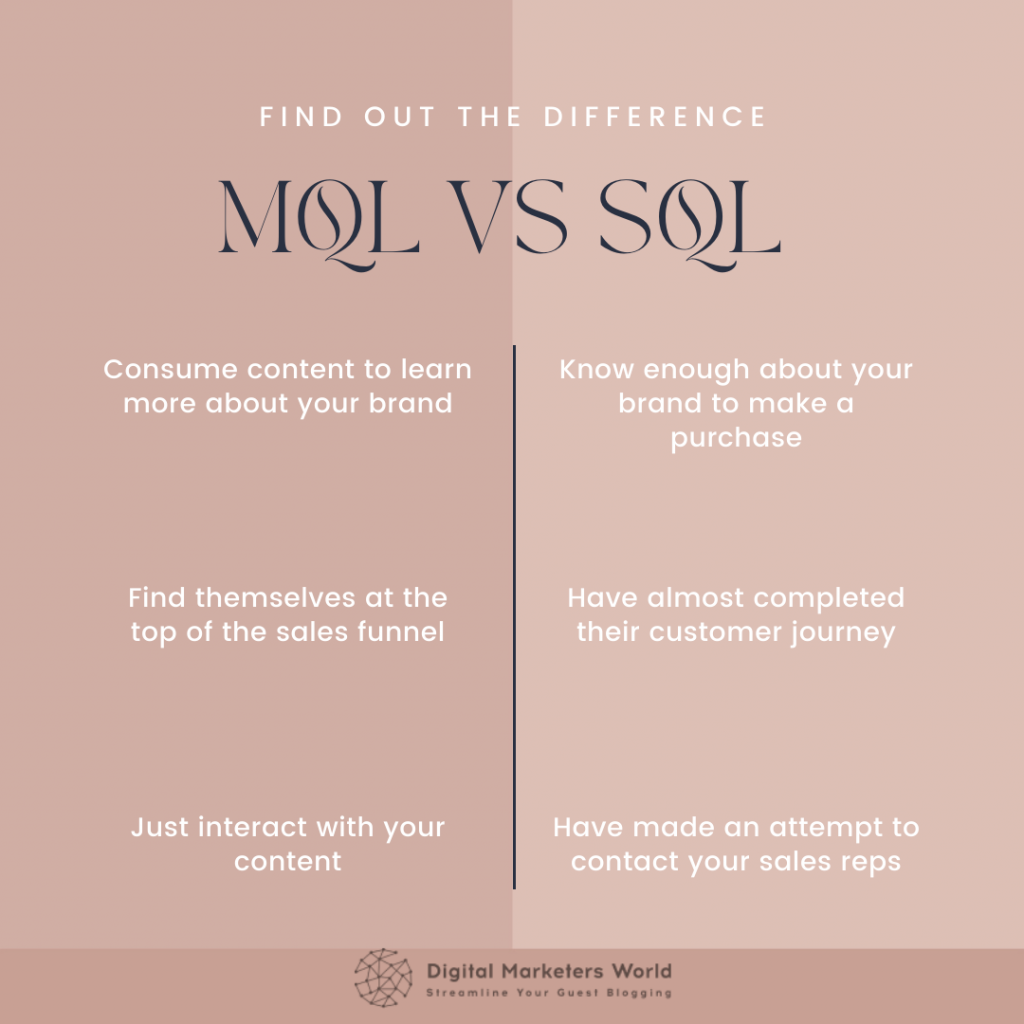
Generally speaking, a marketing qualified lead becomes sales-qualified after the sales department reviews their activity. They might even schedule a talk with the prospect to discuss their needs and show a product demo.
Now, let’s take a closer look at SQLs to understand the differences from MQLs better.
Sales Qualified Lead (SQL)
A sales qualified lead (SQL) is a prospect that has been vetted by the marketing and sales teams and is ready to purchase a product.
The first and most crucial difference is the purchase intent. A marketing lead can download your case study just because they are interested in the information it provides. However, it doesn’t mean they are ready to buy your product just yet.
That’s why it is so important to do lead management and scoring at this point. Lead scoring is a set of requirements that helps you select prospects with more potential to become customers than others.
A must-do move in lead scoring is assigning value to each requirement, as not all scoring criteria are equal. These are usually numerical values between 0 and 10. So, the more requirements a lead fits, the higher their score is.
We can divide all lead scoring criteria into explicit and implicit. The explicit are the ones provided by the prospect on purpose and often include (in the B2B business):
- Company name
- Industry
- Business type
- Company size
- Location
- Revenue
- Title and role in the company
- Purchase authority
The implicit criteria are derived based on analyzing the data from explicit requirements. For example, the person’s location can also indicate the location of their business. Here are some examples of implicit requirements:
- Website visits
- Phone calls
- Content downloads
- Event participation
- Filled-in forms
There are also negative criteria, such as unsubscriptions, lack of response, etc., which can lower the lead’s overall score.
Other points of difference between SQLs and MQLs include:
- The number of website visits – MQLs are usually first-time visitors, while regulars can already be considered SQLs.
- Position in the sales funnel – an MQL finds itself at the top of the funnel, while a sales lead usually has to go all the way down.
- Contact requests – if a prospect makes a move to start communicating the purchase with your sales reps, they are sales-qualified.
The last point pushes us to a question – can a lead be sales-qualified right away?
Yes, it can. Such prospects may not directly interact with your brand and learn about your product from third parties instead. However, they know enough to make a purchase decision and get in touch with a salesperson to close the sale.
Why Identifying MQLs Matters
Of course, there are cases when people buy a product without first being nurtured, but such situations are rare. Most leads start their journey with a brand through different marketing touchpoints.
The reason is simple – for 93% of prospects, the buying process starts with research. They go online, stumble across a few articles of yours, and become marketing-qualified. Yes, they are not ready to buy yet, but you get an opportunity to convince them to do it.
There are a few more substantial reasons to nurture your MQLs besides them being mere opportunities for sales. Take a look.
- Understanding the prospect’s needs. You can figure out the prospective customer’s pain points by looking at the actions they’ve taken. For instance, signing up for a free trial means the lead is interested in your product but is not ready to invest.
- Optimization of lead nurturing campaigns. For example, you can use the contact details (email, phone number, address) provided by your MQLs to run email campaigns to nurture them.
- Improving your sales tactics. All marketing leads initially find themselves at the consideration stage of the sales funnel. If you monitor their behavior at this point, it will help you understand their intentions. Thus, you will have a clearer idea, how to approach them with a sales pitch.
Also, we can’t stress enough the importance of nurturing and scoring your marketing leads along the way. It will save you a lot of time as you will focus only on the prospects that are more likely to buy.
6 Actions that MQLs Might Take
Alright, we’ve covered the reasons to work with your marketing-qualified leads and how to tell them and SQLs apart. But which characteristic features indicate that you’re dealing with an MQL and not a sales prospect?
Here’s a graph just to give you an idea:

And now, let’s go through the most common actions people take indicating that you might be dealing with a marketing lead.
Action #1: Read your blog content
Obviously, a person who stumbled across your blog article one time is not necessarily an MQL. To become marketing-qualified, they need to visit your blog several times.
So, any reader actively interacting with your posts over a long period of time is more likely than others to move down the sales funnel and purchase your product. But how can you find such prospects?
First of all, keep up with the data in your inbound marketing tools. Some of them (e.g., HubSpot CRM) can help you track the activity on your blog and identify potential MQLs.
What if you’re not using any marketing automation software? In this case, you will have to do some research. For example, you can go through the comments under your posts and find people who might be interested in purchasing your solution. Neil Patel’s blog is an excellent example of how active blog readers can be:
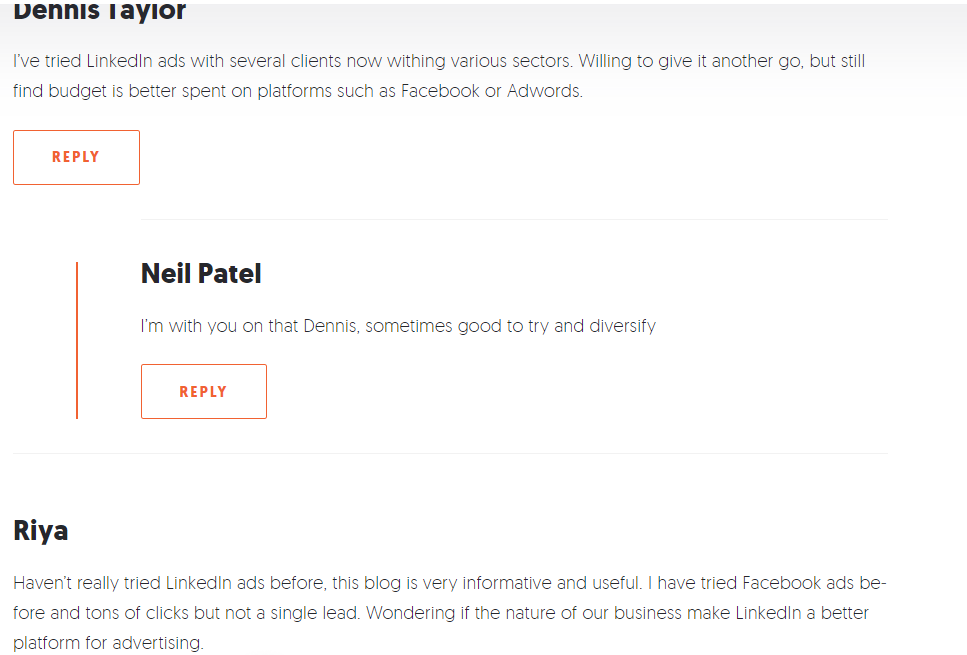
A step forward would be replying to the readers, addressing their comments, and inviting them for further conversation. If they are sharing their pain points or concerns, consider it a signal to action.
Action #2: Visit your website or online shop (and spend time on it)
Similar to blog content, if a person comes to your website and hangs out for a while trying to fish out as much information about your brand or product as possible, they might be considered an MQL.
Note: the time a lead spends on your website or web page is crucial. You can check out the info on the number of sessions and the average session duration for each user in the User Explorer report in Google Analytics:
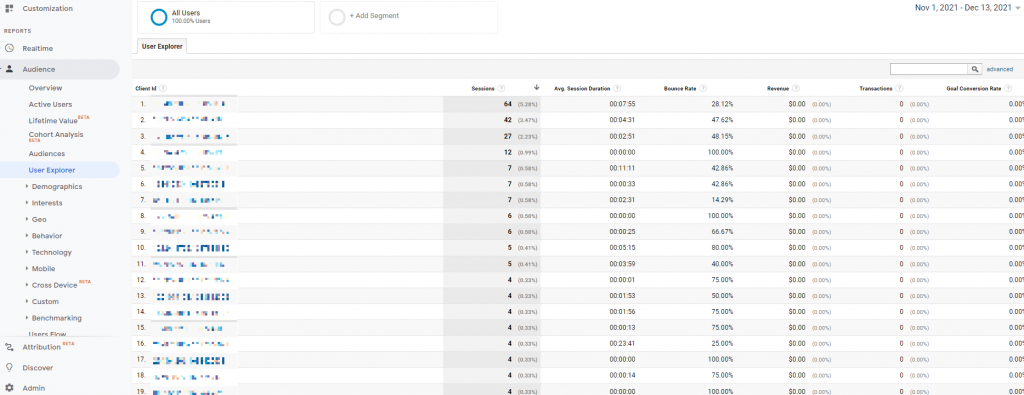
Don’t forget to check the bounce rate – if it nears 100%, disregard this user.
It also wouldn’t hurt to look at the new vs. returning visitors. You can find this data in the Behavior subsection of Google Analytics:
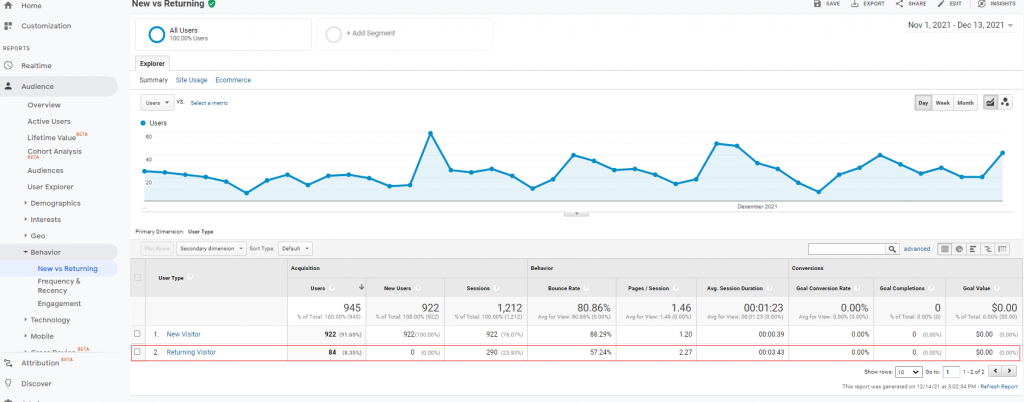
Returning visitors are likely to include those ready to become your buying customers, so take them into consideration.
Note: don’t fret just yet if you see that not many people actually stick around on your website. According to HubSpot, 55% of visitors spend only 15 seconds on a website. However, it doesn’t mean you should do nothing about it. Keep optimizing your content and working on engaging CTAs.
Action #3: Ask for product demos and free trials
Demos, freemiums, and free trials are among the most popular B2B lead magnets (you can learn about other lead magnet ideas here). It’s a chance for a potential customer to experience a product without spending money.
It’s also a chance for you to start nurturing free trial subscribers by adding them to your email marketing campaign. Eclincher went even further by assigning an account manager to each new subscriber:
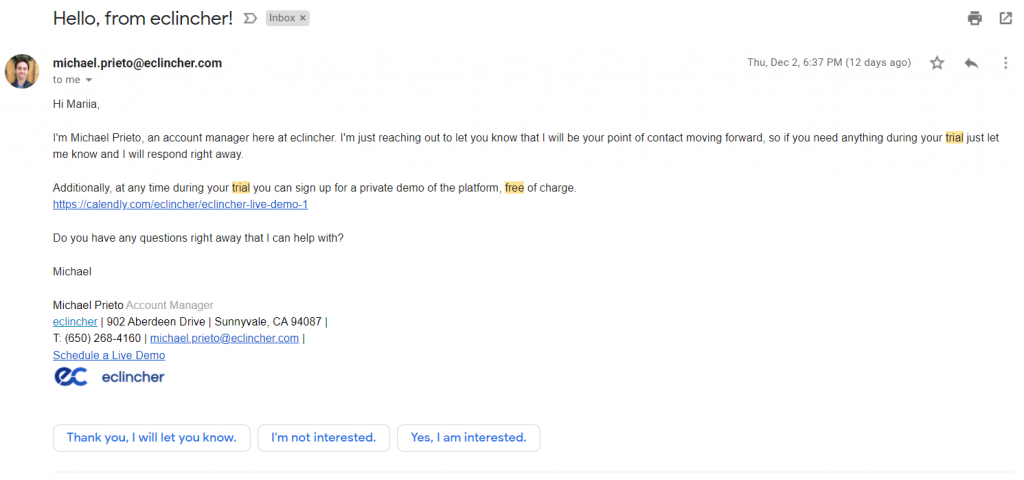
Is subscribing to a free trial 100% indicative of an MQL?
Of course, not. As we’ve mentioned before, you need to do a whole investigation to be sure that a lead is marketing-qualified. They should go through several touchpoints which would show that they have a genuine interest in buying from you.
Action #4: Attend your webinars, courses, events
It’s a common outbound lead generation practice to organize events to attract more prospects. This approach is especially popular among B2B companies: according to Statista, 49% of businesses host around 30 events a year on average:

Events, no matter what type, have the following lead and demand generation benefits:
- Shorter sales cycle. During an event, you get a chance to demonstrate your product, providing enough information for the prospect to start considering making a purchase.
- Brand authority. If you organize a course or an educational event, it puts you in a position of an industry leader, raising your authority in the eyes of a potential buyer.
- A deeper connection with your audience. An event is a perfect opportunity to study your prospect’s needs and offer a reasonable solution that caters to them.
Generally speaking, we can consider event attendees as marketing leads because they choose to participate in them voluntarily. Therefore, they were already somewhat interested in learning more about your product and what it can do. But, of course, it is not enough to say they are 100% marketing-qualified.
Action #5: Sign up for your email newsletter
Are email newsletters still relevant?
Yes, they certainly are, especially in the B2B niche. Reportedly, 81% of B2B marketers say their most popular form of content involves newsletters. It’s not just an option to keep your readers updated; it’s your chance to spot marketing-qualified leads.
Basically, when a person subscribes to a newsletter, they share their email address (and maybe some other contact information):
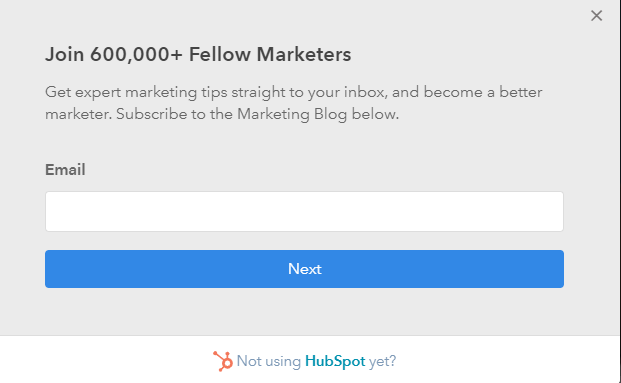
As a result, you get more email addresses to your list, which you can later use to nurture new customers.
Note: an email address alone is not enough to consider such lead marketing-qualified. You still need more information, such as company details, to be 100% sure. Tracking the lead’s behavior (website visits, content downloads, etc.) is also necessary.
Action #6: Download your gated content (such as ebooks, guides, surveys, etc.)
Gated content is a content type used in inbound lead generation, to which prospects get access only after providing specific details (e.g., contact information).
You can use gated content as a part of a lead generation cycle to attract high-quality leads. Such content usually presents a unique value and shares something that would otherwise be hard to find.
Examples of gated content include:
- Ebooks
- White papers
- Case studies
- Guides
- Webinars
- Templates
- Courses
- Research
Basically, you can make any lead magnet gated and use it to collect emails from potential marketing qualified leads.
You can also use the previous newsletter strategy and gated content together as a part of the lead qualification process. For instance, HubSpot invited blog visitors to subscribe to their blog updates (see the subscription form in the previous section), and after that offers a new subscriber to download a free ebook (assuming they like the blog and want to build a similar one):
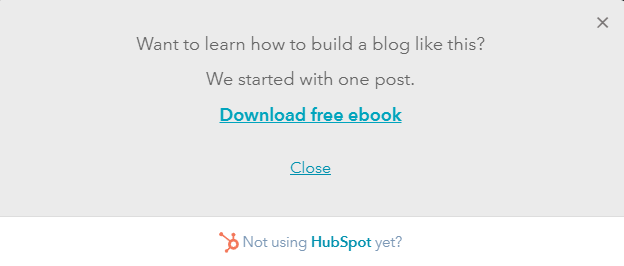
If you click on the link in this form, it redirects you to the landing page with the ebook, but you need to fill in these contact details first:

This is a great example of how you can seamlessly collect leads by offering something of value. The main point here is to find a piece of content that is truly unique and not clickbait just to get more emails. Otherwise, you might lose an MQL opportunity for good.
3 Tips to Make the Most Out of Your MQLs
So, suppose you have a number of MQLs, and you want to make them sales-qualified. How do you do that?
It can be quite a challenge to nurture a marketing qualified lead, but it’s definitely not impossible. Following these three steps can be of huge help, especially if you’re a lead generation newbie.
Let’s jump right in.
Tip #1: Come up with an MQL definition that makes sense
We already shared a general definition of an MQL, its meaning can change depending on the factors that characterize it.
For example, an MQL for one business can mean a lead that fits the ICP, has downloaded an ebook and shared enough contact details. On the other hand, another company might require a lead to subscribe to a free trial or request a demo in addition to other factors before they can be called marketing-qualified.
So, before you set these criteria, sit down with the marketing and sales teams to discuss what defines your ideal MQL and which points you will use in a lead scoring system. As a result, you will reach a unanimous decision that will help stabilize the sales process as well.
Tip #2: Update your tactics regularly
Unfortunately, there is no single right way to do lead generation. It’s a bumpy road, and you will hit quite a few rocks on your way.
For instance, at one point, you may find out that your gated case study does not bring as many MQLs as you hoped. In this case, you need to do a marketing alignment or make an executive decision to scrape it altogether. The lead magnet, whatever it is, should answer the needs of potential marketing leads.
Apart from that, you will need to update your strategy regularly to improve its functionality and performance. Even if something is working well right now, it might not be relevant tomorrow. So, rework your efforts based on the behaviors of your prospects.
Also, take data into consideration – metrics like lead to customer conversion rate and lead-to-sale conversions should be on your daily checklist.
Tip #3: Make sure your marketing and sales teams are aligned
Lead generation requires joint effort; there’s no way around it. If your marketing and sales departments work in silos, they might miss lucrative opportunities trying to turn a marketing lead into a sales prospect.
Your sales team should also be involved in developing content to attract marketing leads. For instance, they might help you craft tailored call-to-actions, and we all know that personalized CTAs convert 202% better. They can also guide you in creating the entire content marketing strategy for lead generation.
Besides, we already know that sales and marketing teams work together on qualifying and scoring leads. Thus, it makes sense to have everyone on the same page – it will help improve the overall lead handoff process (the moment of passing a lead from marketing to sales).
Over to You
So, we’ve figured out that a marketing qualified lead is a prospect that’s almost ready to buy; your sales team just needs to make a few moves to close the sale.
It is absolutely essential to nurture, qualify, and score your MQLs. They have a lot of potential for becoming your customers, but they just need a little guidance through the buyer journey.
You can spot a marketing lead if they:
- Actively read your blog content
- Frequently visit your website and stay around for some time
- Subscribe for free trials or request demos
- Attend your events, both online and offline
- Sign up for your email newsletter
- Download gated content
- Initiate a sales conversation
Of course, these factors alone are not enough to qualify a marketing lead. They also need to fit into your buyer personas description. Otherwise, it’s just a passer-by.
On a more general note, take your time to work out effective lead nurturing and scoring strategies. Work closely with the sales department – being on the same page will speed up the sales qualification process.
Finally, if you want to learn more about lead generation, keep up with our blog. You will find guides, tips, and ideas on how to optimize your digital marketing strategy.
Frequently Asked Questions (FAQs)
In conclusion, let’s answer some of the most common questions regarding MQLs.
Q1. What qualifies as an MQL?
A marketing-qualified lead expresses an interest in a brand by giving a positive response to its marketing efforts. A prospect can be an MQL if they often visit your blog or website, have subscribed to a free trial, attended your event, signed up for a newsletter, or downloaded gated content.
Q2. What’s the difference between a cold, warm, and hot lead?
Cold leads are usually found at the top of the buying cycle. They do not respond or show any interest in your marketing or lead nurturing activities. Warm leads are more familiar with your brand and interact with your content from time to time. Hot leads are sales-ready as they have already been nurtured.
Q3. What’s the difference between unqualified and qualified leads?
Unqualified leads usually are not nurtured enough to close sales. In most cases, they don’t know what you offer and have no idea how your product can help them. On the other hand, qualified leads have gone through your lead nurturing campaign and know exactly which problem your product will help them solve.

Mariia is a content strategist and editor at Digital Marketer’s World. She is passionate about educating others on all things marketing and believes in the power of the written word.
